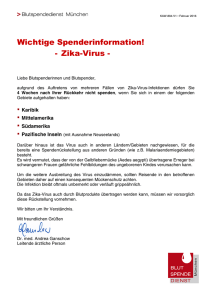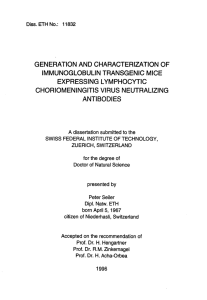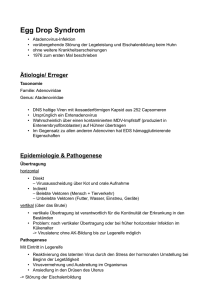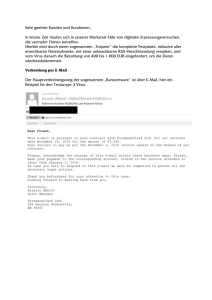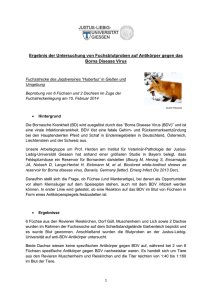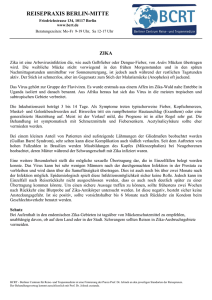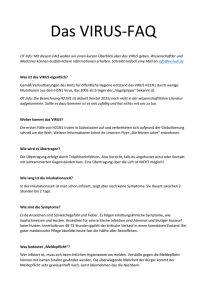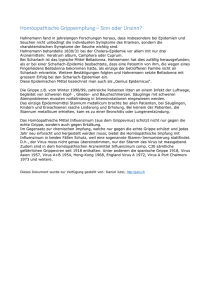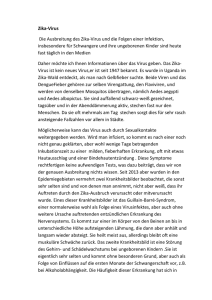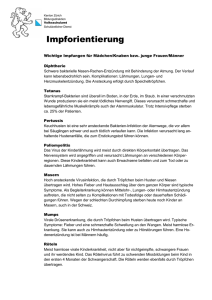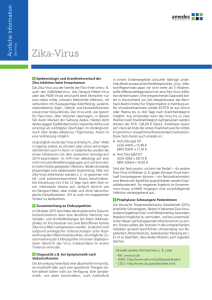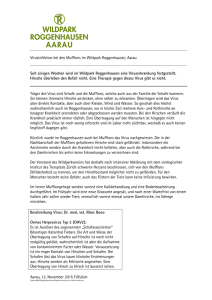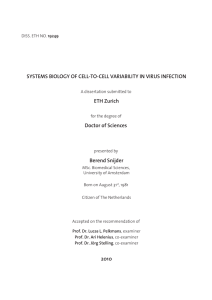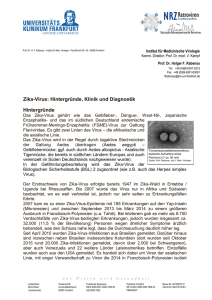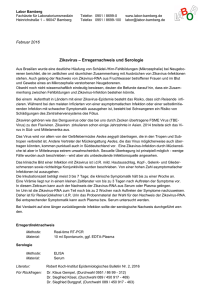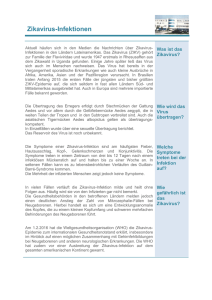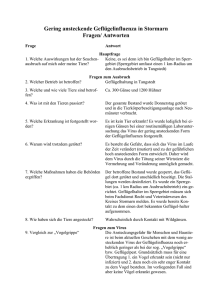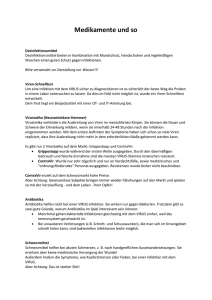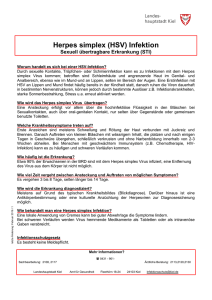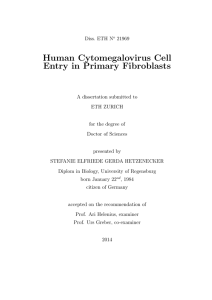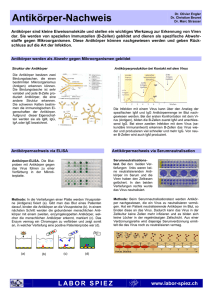Abstract
Werbung
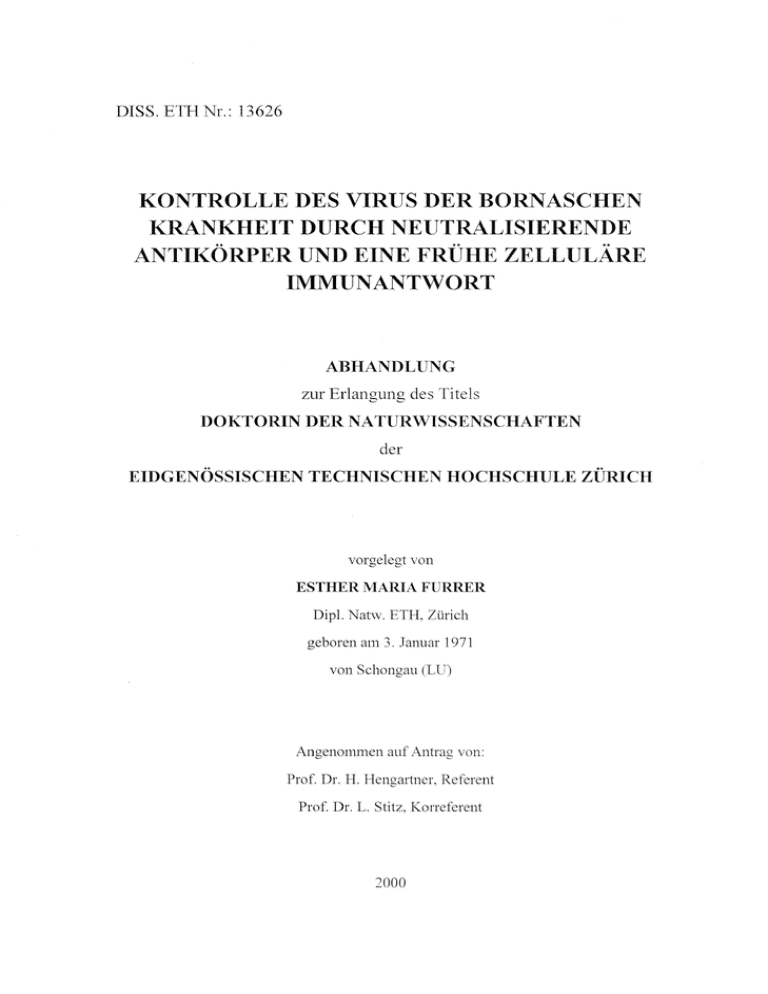
DISS. ETH NI'.: 13626 KONTROLLE DES VIRlJS DER BORNASCHEN KRANKHEIT DURCH NElJTRALISIERENDE ANTIKÖRPER UND EINE FRÜHE ZELLULÄRE IMMUNANTWORT ABHANDLUNG zur Erlanzuna'- des Titels '- DOKTORIN DER NATURWISSENSCHAFTEN der EIDGENÖSSISCHEN TECHNISCHEN HOCHSCHULE ZÜRICH vorgelegt von ESTHER lVIARIA FllRRER Dipl. Natw. ETH, Zürich geboren am 3. Januar 1971 von Schongau (LlJ) Angenommen auf Antrag von: Prof. Dr. H.Hengartner, Referent Prof. Dr. 1,. Stitz. Korreferent 2000 XII ZLlSaml11 enfass LI ng ZUSAMMENFASSUNG In dieser Arbeit wurde gezeigt, dass im Blut BDV-infizierter Ratten fünf bis zehn Wochen vor Auftreten der neutralisierenden Antikörper BDV -spezifische Nucleinsäuren nachweisbar sind. Während der chronischen Krankheitsphase konnten sowohl neutralisierende Antikörper als auch virale Nucleinsäuren im Blut detektiert werden. Der nicht-neutralisierende mAk SP857 entstand nach Fusion von während der akuten Krankheitsphase aus dem Gehirn isolierten B-Lymphozyten, während zur Herstellung der nmAk H12, E6 und BI Milzzellen chronisch infizierter Ratten, welche durch eine Boosterinfektion mit VV-gp94 aktiviert worden waren, fusioniert wurden. Die in vitra-Untersuchungen ergaben, dass neutralisierende Antikörper (polyklonales Rattenserum. nmAk HI2, E6 und BI), im Vergleich zu einem Kontrollserum, in der Lage waren, von Zellen freigesetztes Virus zu neutralisieren, während der intrazelluläre Virustiter nicht reduziert werden konnte. Weiterhin wurde bestätigt, dass der Cterminale Teil des gp94, das gp43, an den durch Senkung des pl-l-Wertes induzierten Zell-Zell-Fusionen beteiligt ist. Neutralisierende Antikörper konnten in vivo eme fortschreitende Infektion nicht verhindern, sofern das Virus die Nerven zuerst infiziert hatte. Die Infektion konnte blockiert werden, indem die neutralisierenden Antikörper in ausreichender Menge vor einer subcutanen Infektion in der Peripherie vorhanden waren und dadurch die Viruspartikel am Infektionsort zu neutralisieren vermochten, bevor diese die Nervenzellen infizieren konnten. Im Rahmen dieser Arbeit wurde ferner gezeigt, dass sich die Infektion mit niederen Dosen (10 2 - 4 10 ffu) BDV 4p bzw. BDV-CRL in vivo in der Ratte nicht unterschieden, während die Inokulation des zelladaptierten BDV -NIDCK zu einer Verzögerung des Auftretens der ersten klini sehen Symptome von rund 40 Tagen führte. Dagegen führte die Infektion mit einer hohen Dosis (10 6 ffu) zur fast vollständigen Elimination des Virus (BDV-MDCK) bzw, zur Kontrolle des Virus im Hippocampus und in] Hypothalamus und in der Folge zur Ausbildung einer Fettsucht (BDV-CRL). Diese war gekennzeichnet durch deutlich erhöhte Serumleptinspiegel. Verantwortlich für die Elimination bzw. Kontrolle des Virus waren die CD8+ T<Zellen. BDV -CRL replizierte im Vergleich zum BDV -MDCK im Gehirn immunsupprimierter Ratten viel effizienter, was durch die hohen Virustiter dokumentiert wird. Summary XIII SUMMARY It could be demonstrated that viral nucleic acids are present in the blood 5- 10 weeks before neutralizing antibodies appeared in the serum. Both neutralizing antibodies as well as viral nucleic acids were found in the blood of chronically infected rats. The non-neutralizing monoclonal antibody SP857 was generared by B-cell fusion of brain lymphocytes, whereas the generation of the neutralizing monoclonal antibodies H12, E6 and BI was done by fusion of spleen cells activated after a booster infection with a recombinant Vaccinia virus expressing the BDV glycoprotein gp94. It could be demonstrated that polyclonal neutralizing rat serum as well as the neutralizing monoclonal antibodies H12, E6 and 13 1 were able to neutralize the virus in cell culture supernatant, whereas control sera obtained from uninfected rats did not. The intracellular virus titer was not reduced by the neutralizing antibodies. Furthermore. neutralizing antibodies did not inhibit an ongoing infection, after the virus had infected neuronal cells, The infection was blocked, if neutralizing antibodies were present in the organism before the viral infection, so that the virus particles were not able to infect the neuronal cells because of prior neutralization at the site of infection by the antibodies. The gp43, the C-terminal part of the BDV-glycoprotein gp94, is very important for the infection of adjacent cells in eell culture. The incubation of BDV-Vero eells with neutralizing antibodies prevented the pll-dependent cell-cell-fusions, which could be seen in untreated cells. No differences were found between infection with low doses (Hi - 104 ffu) of BDV 4p 01' BDV-CRL virus, whereas the inoculation of BDV-MDCK virus led to a delay of about 40 days in the appearance of clinical symptoms. 6 A high dose infection (l0 ffu) with BDV-MDCK virus led to nearly complete virus clearance, whereas a high dose infection with BDV-CRL virus led to virus contro1. In these animals virus could only be found in the hippocampus and the hypothalamus. These animals developed an obesity syndrome and had significant higher serum leptin levels as compared to controls. The cytotoxic T' cells turned out to be very important for virus clearance (BDV-IvlDCK) 01' virus control (BDV-CRL). BDV-CRL virus replicates very efficiently in the brains of immunsuppressed infected rats, whereas the BDV -MDCK virus did not.
